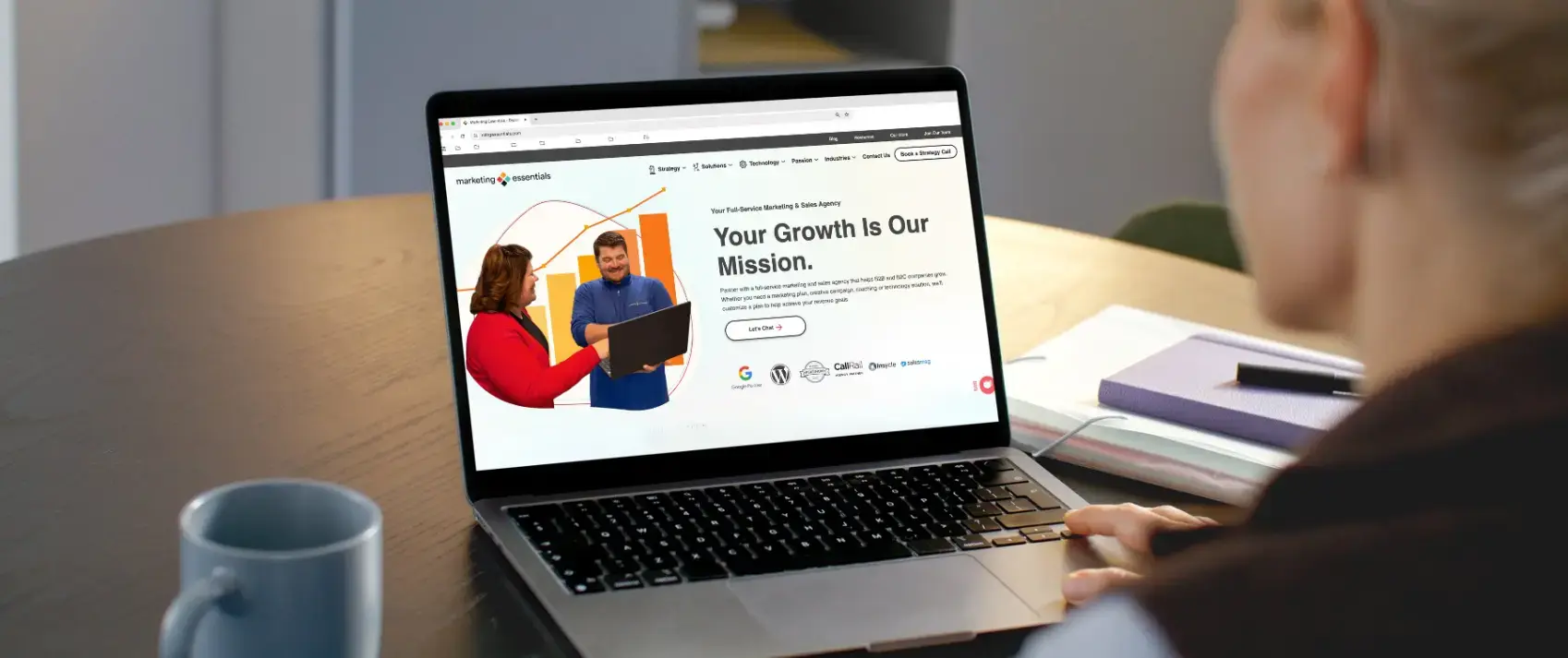There are numerous ways to reach your ideal customer through digital marketing campaigns, virtual and in-person events, video, streaming services and much more. But before you go galloping out into the world shouting about your offering, you must first figure out how to reach and connect with your target audience in a way that’s personal, relevant, unique and relatable.
In this essential guide to crafting a marketing message, we’ll define what a marketing message is, why your business needs one and walk you through the steps to create a compelling one that moves people to take action.
What is a Marketing Message?
So you’ve got a product or service you want to sell. Great! Now, how are you communicating with your target audience about what you’re offering?
The way you talk to (and with) your audience — your emotional tone, word choice, style, and personality — forms part of your brand identity. The written aspect of this identity becomes your marketing message.
Consistency is key. If your business sends out multiple, conflicting messages, or no clear message at all, your brand becomes muddy and forgettable. People won’t know what you stand for, and they won’t remember you.
Most marketing messages are built on a value proposition — a clear statement explaining why your company exists and the benefits it provides. (I’ll guide you through creating one below.)
From this value proposition, you can develop a tagline and a consistent set of messages to use across your website, social media, ads, press releases and more. These messages should always speak in a voice your audience recognizes and trusts.
A well-crafted marketing message lays the foundation for all of your marketing and sales efforts. Having a clear, consistent and impactful message can be the difference between a campaign that generates huge results and one that falls flat.
Why Does My Business Need a Marketing Message?
We are all bombarded with hundreds and sometimes even thousands of marketing messages every day - via email, social media, online sites, streaming services, flyers, television, billboards, and within apps.
Your company is competing with all of those other messages to stand out and grab your potential customer’s attention. A generic, uninspired and forgettable message that doesn’t communicate the value of your product or service will simply get lost in the noise.
Remember the old saying, “If you build it, they will come?” If nobody knows what you’ve built, how would they know when, where and why they should come? A product or service nobody knows about simply isn’t going to be purchased.
That’s why having a compelling marketing message – which you can then leverage across your marketing campaigns – is so vital to the success of your business.
Can I Use ChatGPT to Write My Marketing Content?
Yes – but only when used the right way.
AI tools can assist – let me say it again, assist – in content creation. For example, ChatGPT, Claude or another AI writing tool can help generate ideas faster than any human brain, draft outlines for efficient content development, help personalize messages for different audience segments and even provide a solid first round of edits.
At Marketing Essentials, we do use AI tools to support content development but we follow clear principles. We believe AI will never replace content writers and marketers. Instead, those who use it ethically can boost their efficiency and enhance their creativity.
AI can be a valuable starting point, but exceptional marketing still requires human insight, strategy and heart. We believe in the power of genuine human content, with AI playing a supporting role, not taking the lead.
Let’s Get Started: How to Craft a Compelling Marketing Message
Creating a strong marketing message starts with a deep understanding of your target audience, your value, and your voice. Follow these steps to shape a message that resonates.
1. Define Your Target Audience
Before you can create a message that resonates, you need to clearly understand who you're speaking to. The more you know about your ideal customer, the more focused and effective your messaging will be.
Start by outlining key demographic details: age, occupation, location, education level, and any other characteristics relevant to your product or service.
Then, dig deeper into their mindset. What challenges or frustrations do they face? What motivates them to take action during their buyer’s journey?
If you haven’t already, use this information to create a buyer persona. This will help you craft messaging that speaks directly to what your audience values most.
2. Define the Value You Offer
Now that you know their pain points, clarify how your product or service helps solve them.
- What’s your mission, vision, or core values, and how do those translate into real value for your customer?
- What are the top benefits of your product or service?
- Why does your business exist?
- What makes your offering unique?
3. Evaluate Your Competitors
Take a look at others in your industry.
- How are they positioning themselves to stand out?
- What words and phrases are they using?
- What value are they communicating to their customers?
Analyze what they’re offering, and then identify how your solution is different or better. Use these insights to refine your own positioning and clearly highlight your competitive edge.
4. Define Your Brand Personality
How do you want your business to be perceived? Your brand personality shapes the tone and voice of your marketing; it influences how you communicate and how people connect with you.
Start by selecting a few adjectives that best describe your brand’s character. Here are some example personalities and matching descriptors:
- Nerdy/Smart: Brainy, Clever, Thought-Provoking
- Fun/Lively: Joyful, Witty, Spirited
- Unconventional: Offbeat, Unique, Bold
- Helpful/Community-Focused: Generous, Cooperative, Supportive
- Attractive/Irresistible: Elegant, Enchanting, Polished
To help you uncover your brand personality, ask yourself:
- How do others describe our brand?
- If we could only use three words to describe our brand, what would they be?
5. Write Your Value Proposition
Now that you’ve defined your audience, identified their challenges, clarified the value you offer and evaluated your competition, it’s time to bring it all together.
Your value proposition is a concise statement that clearly communicates the unique value your product or service provides — from the buyer’s perspective. It should focus on what matters to them, not on your company or internal achievements.
Tips for Writing Your Value Proposition:
- Keep it short and clear. Aim for one or two sentences.
- Focus on outcomes, not features. Highlight the result your customer will experience.
- Use natural, everyday language. Avoid jargon or vague buzzwords.
- Make it specific. The more tailored to your audience, the better.
- Lead with the customer. Use “you” more than “we.”
This statement may evolve into your brand’s tagline or slogan, or you might create slightly different versions for different product lines or business divisions.
Examples of strong value propositions:
Uber: Go anywhere with Uber.
Mailchimp: Turn emails & SMS into revenue.
Marketing Essentials: Your growth is our mission.
Note how each focuses on customer benefit — speaking to “you,” not “us.”
6. Develop Your Marketing Message(s)
Now, turn your value proposition into full marketing messages tailored for specific channels, such as your website, emails, social posts and ads. Document this in your brand guidelines.
When crafting each message, ask yourself:
- Is the message clear and engaging?
- Does it highlight your unique value?
- Will your audience immediately understand why it matters to them?
Visualize your message front and center on your homepage or in a campaign headline. If it doesn’t immediately resonate, refine it until it does. Your message should stop the scroll, spark curiosity, and drive action.
Additional Tips for Crafting Your Marketing Message
As you continue to develop marketing messages for various marketing and sales materials and campaigns, consider the following additional tips to help you create compelling messages based on your value proposition.
Use Emotion + Logic
People are moved to buy products and services based on both emotions and logic. Your message should tap into your audience’s emotional impulses and back up those impulses with logical reasoning.
Stand Out
Why should people do business with your company over one with a similar offering? There should be both emotional and logical reasons to do so, and these should be encompassed in your marketing message.
Speak Like Your Customer
Your message should be communicated in the same way that your customers speak. Use the type of language and word choice that they do.
Speak From the Customer’s Perspective
When creating marketing messages, always speak directly to the customer’s needs. It’s not about you! Avoid a message that only talks about the company, often starting with “we” or “our.” Instead, speak to your customer.
NO: We are the leading provider of financial software solutions for businesses, saving them time and money by helping them streamline their finances.
YES: Start saving money this month with an easy-to-learn software solution built by business owners just like you!
Put It All Into Action
Now it’s time to take that messaging and put it into impactful marketing campaigns. Use our free marketing plan template. Download it to get:
- A Goal Setting Framework
- Competitive Analysis Tools
- Buyer Persona Examples
- Strategy Maps
- Creative Examples
- Budget Charts
- And much more!



